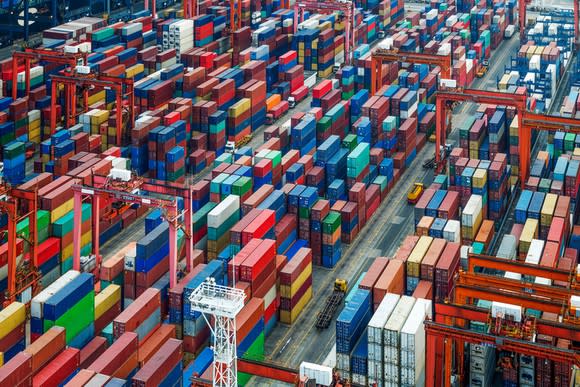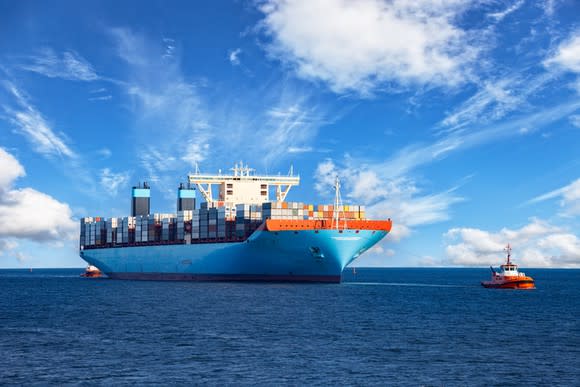Is Seaspan Corporation a Buy?
After years of turmoil, the shipping industry is on the rise once again. But that was bound to happen eventually, with daily charter rates near 50-year lows in recent years. It would've been difficult for the environment to deteriorate much further.
Rental rates aren't the only thing gaining momentum. Several companies are demonstrably stronger today, including containership leader Seaspan (NYSE: SSW). The investor favorite has made moves to strengthen its long-term prospects just in time to capitalize on rebounding global demand for shipping vessels of nearly every size. Throw in the purchase of a Chinese joint venture, which injected youthful vessels and new contracts into the business, and a $500 million investment from a major shareholder, and it's easy to see why shares are up 80% in the last year alone.
But how much further can the stock rise? Is Seaspan Corporation a buy?

Image source: Getty Images.
By the numbers
The containership company turned in another solid period of growth in the first quarter of 2018. The business grew revenue, earnings, and cash available for distribution compared to the year-ago period and announced several updates that excited investors. Here's how the most recent quarter stacked up to the first quarter of 2017.
Metric | Q1 2018 | Q1 2017 | % Change |
|---|---|---|---|
Revenue | $224.8 million | $201.3 million | 11.6% |
Net income | $67.7 million | $40.0 million | 69.2% |
Adjusted net income | $35.3 million | $31.8 million | 10.9% |
Cash available for distribution | $65.5 million | $60.3 million | 8.6% |
Adjusted EBITDA | $135.2 million | $119.3 million | 13.3% |
Data source: First-quarter 2018 earnings press release.
The growth reflected in the table above was derived from efforts in recent years to stabilize the existing business and an improving shipping industry at large. The effect of the latter cannot be understated.
Consider three data points detailing industry tailwinds:
Utilization rates are high: In 2016 and 2017, as much as 8% of the global shipping fleet was idle for extended periods of time. In other words, there was a sharp mismatch in supply and demand. In 2018, no more than 3% of the world's fleet has been idle at any one time, signaling a more balanced market.
Available vessels in short supply: The number of available shipping vessels ranging from 4,000 twenty-foot equivalent units (TEUs) to 10,000 TEUs is at a multiyear low. Nearly 100 of these vessels were available at the start of 2017, but that dipped to around 10 in April 2018.
Orders are at historic lows: This might be the most critical data point. In previous periods with high utilization rates and short supply, containership owners raced to build new ships -- and vastly overshot expected demand. That's why the shipping industry has been stuck in epic boom-bust cycles for decades. It might be too soon to say the industry won't repeat the same mistakes, but orders today are at their lowest point in over 20 years.
A more balanced and disciplined market is bullish for daily charter rates, both in the near and long term. Consider that vessels of 2,500 TEUs to 4,000 TEUs have seen their rental value rise from around $6,000 per day at the beginning of 2016 to $11,000 per day in March 2018. Larger vessels of 8,000 TEUs have enjoyed a price bump from under $8,000 per day to over $20,000 per day in the same span.
The macro environment is all good news for Seaspan, which expects healthy growth in the near term from a combination of its existing business and strategic acquisitions. Its latest acquisition could prove to be the most important for shareholders.

Image source: Getty Images.
An earnings catalyst about to show up on the income statement
Management expects a strong showing in the second quarter of 2018, with revenue rising to around $280 million. Investors can expect growth to continue for the remainder of the year following a big move that will be immediately accretive to earnings. Seaspan recently acquired the 89% of Greater China Intermodal Investments (GCI) it didn't already own.
GCI is a joint venture formed years ago between the containership leader and Carlyle Group as a way to build new shipping vessels and secure new contracts. The expectation was always that Seaspan would eventually acquire GCI, and it finally completed the deal in the first quarter of 2018 by paying $330 million in cash and $50 million in preferred shares. It promises to be a huge catalyst. The deal simplifies the company's structure, boosts its fleet size, and increases its revenue backlog by $1.3 billion to $5.6 billion.
Seaspan will own 8% of the global market following the acquisition of GCI, easily making it the world's largest containership owner. That could help to boost earnings by 20% in 2018 -- and that's before factoring in the company's ability to lease vessels with contracts expiring this year at the current market's higher rates.
Additionally, the deal was made possible by Fairfax Financial's decision to increase its investment in Seaspan by $500 million, to a total of $1 billion -- all of which was committed in the last five months. The company received $250 million up front, and will receive another $250 million in January 2019. It's a major vote of confidence from a leading shareholder.

Image source: Getty Images.
Smooth sailing ahead for Seaspan?
Things haven't been fun or comfortable for Seaspan shareholders, who have endured all the volatility of the last few years. Case in point: Shares might have delivered total returns of 80% in the last year, but they've lost 42% of their value in the last three years. In other words, this shipping stock has to climb quite a bit further in order to make shareholders forgive the recent journey through the market.
That said, the business appears poised to deliver growth for the next year at least and possibly for years to come. The acquisition of GCI and higher daily charter rates bode well for higher revenue and earnings going forward. Simply put, the stock's recent rise shouldn't necessarily scare investors away from Seaspan, although investors need to carefully watch that the global containership industry doesn't return to its old habit of ordering too many new ships now that smooth sailing is ahead. That could lead to the next bust -- and plenty more misery for shareholders.
More From The Motley Fool
Maxx Chatsko has no position in any of the stocks mentioned. The Motley Fool has no position in any of the stocks mentioned. The Motley Fool has a disclosure policy.
